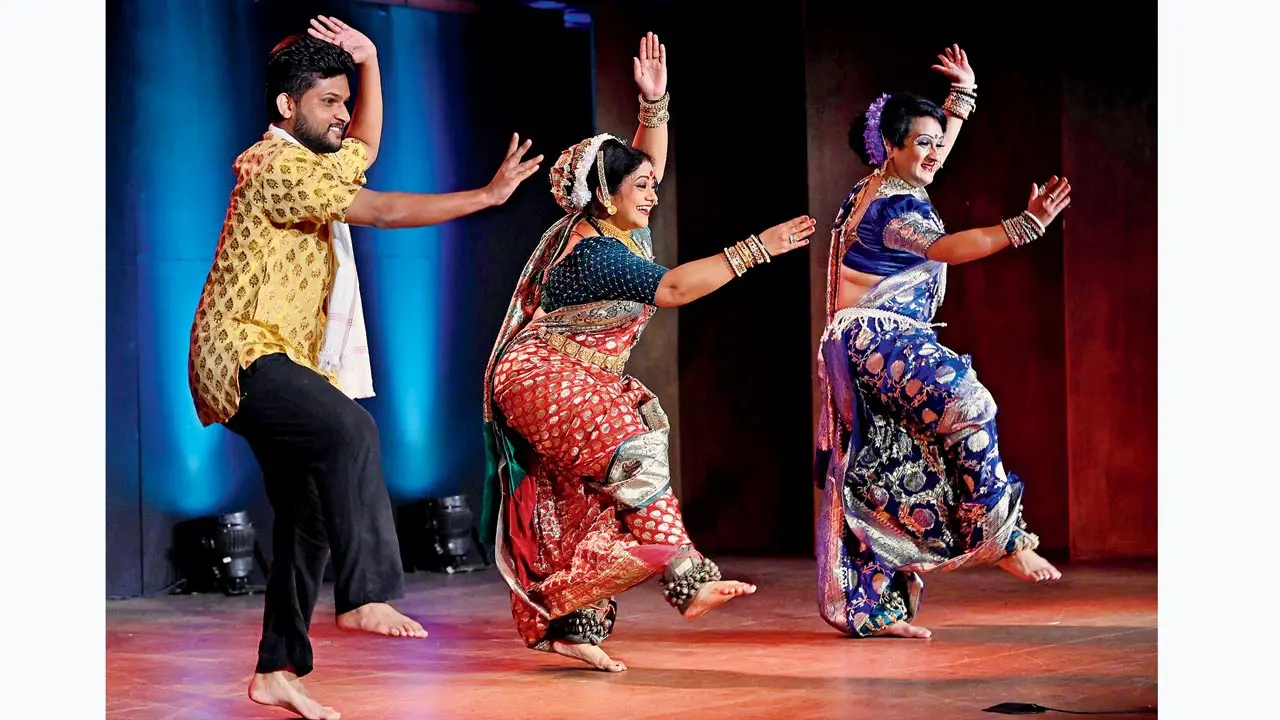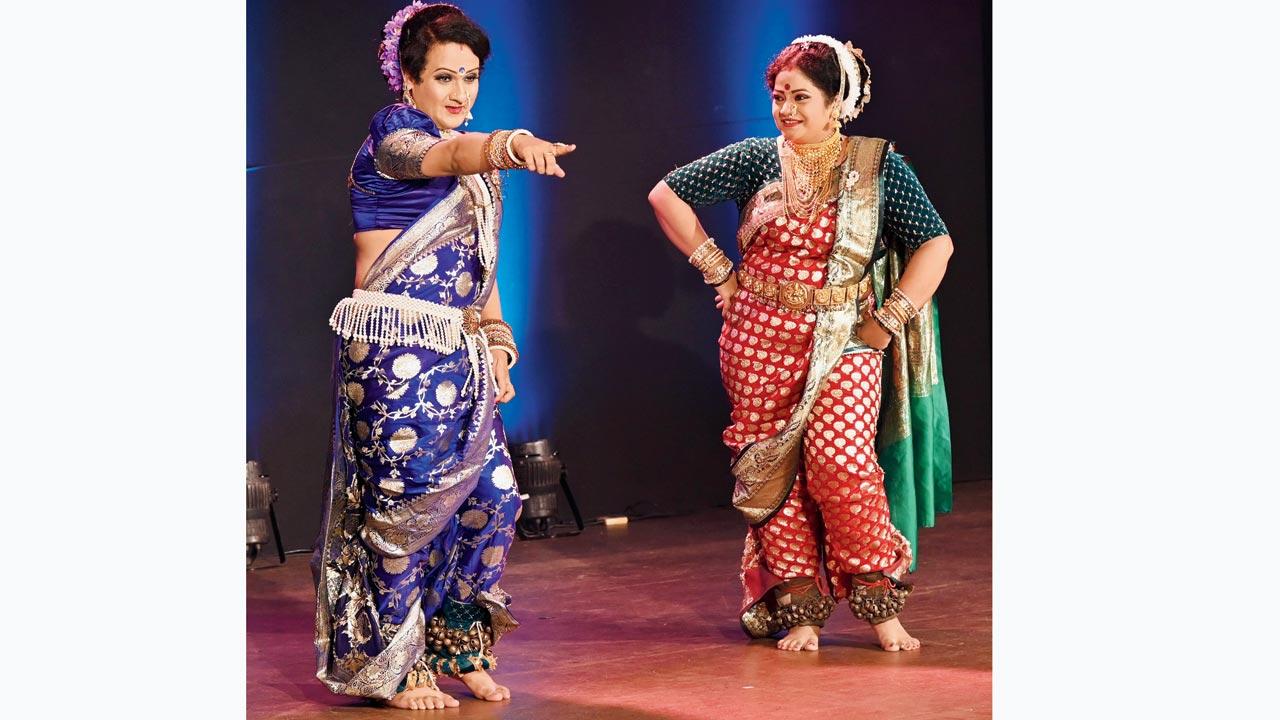A new Lavani performance puts stories of queer love front and centre, accompanied by original music, queer performers, and a fresh interpretation of the folk form

Performers rehearse Rang Birangi’s gender-fluid choreography
Bollywood has flattened the art form of Lavani into homogenised item numbers. But the folk form has always throbbed with rhythm, resistance, and sensuality. In its lyrics were secrets of love, flirtations that refused gender’s grip, and performances that blurred the lines between the masculine and feminine.
In Rang Birangi Lavani, a show premiering at Veda Kunba in Four Bungalows in Andheri on June 26, that tradition takes a unique interpretation with an acknowledgement of the queerness of the form, showcasing gender-fluid love stories.
Bhushan Korgaonkar, who published the book Sangeet Bari, on Lavani and its roots in 2014, takes on the role of co-writer and co-director for the act, along with Kunal Vijaykar. The Lavani performers are Gauri Jadhav, Akshay Malvankar and Sopinath Patokar.
Korgaonkar and Vijaykar have backed the performance with care. Don’t mistake it for a reimagination, it is in fact an acknowledgement of the queerness of Lavani. “We had been thinking of showcasing queer stories for some time. Lavani just seemed to be the best way to bring those forward because the form is very fluid,”
says Vijaykar.

Featuring four original songs written specifically for this act, the production is an anthology of sorts, and explores stories of cross-caste and cross-cultural love, same-sex desires, masculine sensuality, and gender nonconformity — some of which are realities Lavani had always hinted at, but never too explicitly.
“Historically, Lavani has been performed by women and men dressed as women. Stories, too, never clarify gender. It’s never such that you would feel like only a woman is speaking,” explains Korgaonkar, telling us that it’s why the folk form seemed ideal to talk about stories of love of every kind. “But not all stories are about love among humans. Really, it’s about how there is love in all of us, and that it can happen with anyone or anything. One of my dances is about my love for make-up, Gauri has one about her love for trees,” says Malvankar. He adds that the audience from the two shows they have performed at has so far loved it, because there is something for everyone. “Some stories are complex, others are easy. There’s love, lost lovers, lack of acceptance… everything. Queer or not, you can relate,” he adds.
In crafting this act, the creators of Rang Birangi Lavani quickly realised that while folk songs captured many moods, they often skipped over the narratives they wanted to spotlight. “One of the love stories is about a same-sex couple, but it’s across caste. There was no traditional song that we could use; that’s why we decided to create an original composition,” says Vijaykar. It’s why he and Korgaonkar brought in music directors Vikas Rawat and Khmosh Shah to compose music.
Another one of the other four originals was composed for what you could call the production’s boldest choice: The inclusion of a mardani Lavani. Performed by Patokar, this style of Lavani has perhaps never been attempted before. A versatile performer, Patokar presents the mardani Lavani without straying too far from the traditional form. The choreography keeps the masculine energy and sensuality intact, and it’s the production’s attempt at breaking gender-binary norms. Explaining how he went about the choreography, Patokar says, “Lavani has mujra gestures, but not even one per cent of them are masculine. So, I had to look at gestures that men usually use and add them to the dance without it seeming unauthentic or feminine in any way.”
Was there any hesitation in performing queer stories through Lavani? Jadhav admits her hesitation, but says it quickly went away. “We discuss and dissect each story during practice. I think that, and talking to the group made me realise that love can happen with anyone. There’s also a lot to learn from this act about love and how to sustain it,” she says.
Vijaykar hopes that through the performance, the audiences realise that being queer is different, but not too different as well. “This othering of queer people should go away. We are all humans, so we are not too different from each other,” he says.
“There’s a famous line in Marathi, ‘Prem mhanjhe, prem mhanjhe, prem asta, tumcha aamcha agdi same asta’ [love is love is love, your’s or ours it’s just the same]. That is the takeaway I want for the audience,” concludes Korgaonkar.
The all-male troupe
Before Rang Birangi Lavani brought queerness to the Lavani stage, Bin Baykancha Tamasha, meaning Tamasha without women, pushed boundaries with an all-male Lavani troupe. Founded by Anil Vasudevan, the group flipped the script on Maharashtra’s folk theatre with men performing Lavani with full conviction: draped in sarees, adorned in jewellery, and trained in every gesture and expression.
It became a cultural statement, and audiences were often so taken, when they didn’t realise the dancers were not women.
Though the group no longer performs regularly due to funding issues, their legacy stands tall. In a form still grappling with stigma, Bin Baykancha Tamasha proved that masculinity, performance, and gender expression could be fluid and deeply captivating.
 Subscribe today by clicking the link and stay updated with the latest news!" Click here!
Subscribe today by clicking the link and stay updated with the latest news!" Click here!










